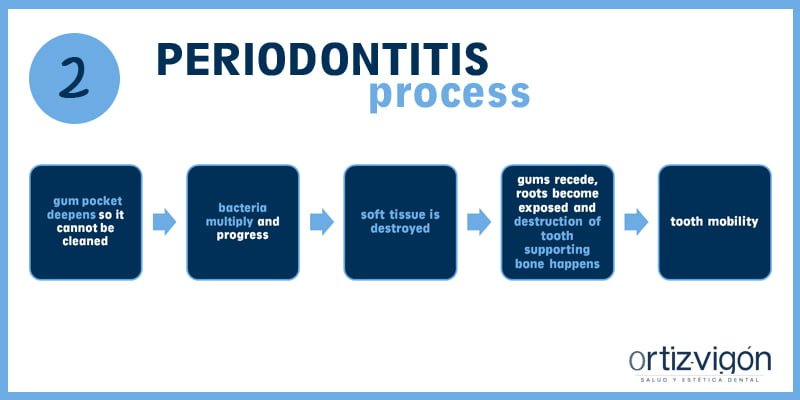As every May 12, it is celebrated the European Gum Health Day. The commemoration of this date is promoted by the European Federation of Periodontology (EFP) and driven in Spain by SEPA (Spanish Society of Periodontics and Osseointegration). As specialists in periodontics and implants, we sum up to the initiatives of spreading and raising awareness on gum diseases. We would like to present the handbook of gum disease.
What is the periodontium?

Anatomically, tooth is divided into two parts: on the one hand, there is the crown, is the visible part we bite with; and on the other hand, there is the root, the invisible part which fixes the tooth to the bone. And, What is the periodontium? It is those tissues that surround and support the tooth. It consists of 4 components:
- Gum: the pink, visible cover.
- Periodontal ligament: attachment fibres fastening tooth to the bone.
- Cementum: covering & holding the root.
- Alveolar bone: where the root is anchored.
What is gum disease?
Periodontal disease is a genetic kind of disease, which is firstly developed producing an inflammation on gums that has been previously originated by bacteria. If it progresses, it will affect support tissues, finally causing their own destruction.
Which serious conditions can be associated withgum disease?
Gum disease is significantly associated with serious chronic conditions such as:
- Diabetes: as we have already explained in previous occasions, diabetes and gum disease are narrowly tied. In Ortiz-Vigón Clinic, we are developing a study for the early detection of diabetes in dental clinics, promoted for SEPA. How to take part? It is easy.
- Cerebrovascular disease: arteries supplying oxygen and nutrients to the brain are often damaged or deformed in these disorders. The most common presentation of cerebrovascular disease is an ischemic stroke or mini-stroke and sometimes a hemorrhagic stroke. Hypertension (high blood pressure) is the most important contributing risk factor for stroke.
- Chronic obstructive pulmonary disease: is a type of obstructive lung disease characterized by long-term breathing problems and poor airflow.
- Heart disease.
- Chronic kidney disease.
- Rheumatoid arthritis.
Progression of gum disease: gingivitis and periodontitis
There are two types. On the one hand, we can find gingivitis, which is a gums’ inflammation. On the other hand, there is periodontitis, which comes out when the support bone shows signs of destruction together with gingival swelling.
1. Gingivitis
Gingivitis is gums’ inflammation. It may sho due to some factors:
- Poor oral hygiene.
- Pregnancy hormones.
- Diseases and other factors.
Gingivitis appears as lack of proper oral hygiene that allows the accummulation of bacteria. Food debris accumulates between the tooth and the gum line, so dental plaque increases. Bacteria proliferate and plaque mineralises. Body reacts by sending healing and immune cells to the gingiva. Increased blood flow produces red, swollen, tender gums prone to bleeding. At this point, attachment fibres remain intact so there is no irreversible damage yet.
The solution for gingivitis is a mechanical plaque removal by professionals, good oral hygiene habits, brushing twice a day including interdental cleaning if advised by the periodontist.
2. Periodontitis
If gingivitis is not treated, it can result in periodontitis. If the patient suffers form periodontitis, gum pocket deepens so it cannot be cleaned effectively. Bacteria multiply and progress downwards. Soft tissue is destroyed. Then, gums recede roots become exposed and destruction of tooth supporting bone happens. That means tooth mobility and loose tooth.

The treatment for periodontitis consists of root surface debridement. It also needs an oral hygiene improvement, as well as a follow-up by the periodontist.
3. Severe periodontitis
The treatment for periodontitis consists of root surface debridement. It also needs an oral hygiene improvement, as well as a follow-up by the periodontist.
3. Severe periodontitis
And, what happens if periodontitis is not treated? Severe periodontitis shows up. At this point of gum disease, there is pathological tooth loss, masticatory dysfunction, altered speech, serious aesthetic issue, risk of interaction with systemic diseases.
The solution to severe periodontitis is root surface debridement and possible application of local or systemic antimicrobials. Then, there should be a re-evaluation by your periodontist and, if needed, periodontal surgery.
How to detect periodontal disease
Inflammation, reddening and gum-bleeding are the symptoms the patient himself/herself can detect. We, professionals, will identify the periodontal disease after carrying out a check with a specific periodontal catheterization. If symptomatology exists, we will proceed with some radiographic series.
How can we prevent it?
The susceptibility to suffer from this disease is cannot be prevented. However, we can foresee its development with an exquisite oral hygiene, avoiding bad habits like smoking and regularly attending the periodical revisions and periodontal maintenances with the frequency the doctor determines.





